【初中英语】Natural disasters教案2 译林牛津版
- 格式:doc
- 大小:88.00 KB
- 文档页数:12
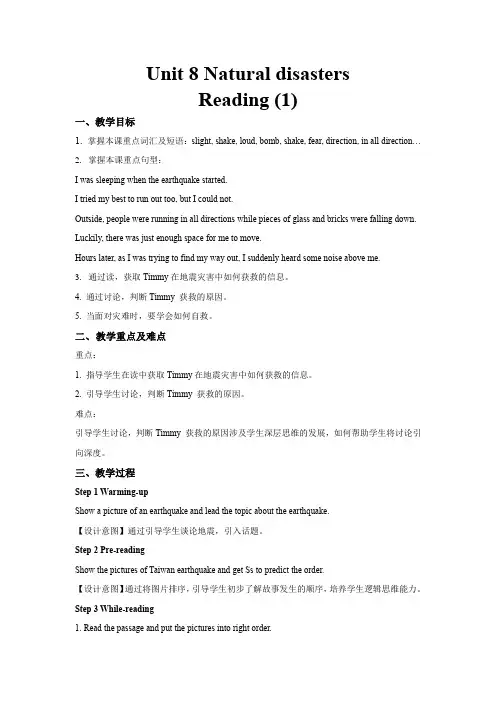
Unit 8 Natural disastersReading (1)一、教学目标1. 掌握本课重点词汇及短语:slight, shake, loud, bomb, shake, fear, direction, in all direction…2.掌握本课重点句型:I was sleeping when the earthquake started.I tried my best to run out too, but I could not.Outside, people were running in all directions while pieces of glass and bricks were falling down. Luckily, there was just enough space for me to move.Hours later, as I was trying to find my way out, I suddenly heard some noise above me.3.通过读,获取Timmy在地震灾害中如何获救的信息。
4. 通过讨论,判断Timmy 获救的原因。
5. 当面对灾难时,要学会如何自救。
二、教学重点及难点重点:1. 指导学生在读中获取Timmy在地震灾害中如何获救的信息。
2. 引导学生讨论,判断Timmy 获救的原因。
难点:引导学生讨论,判断Timmy 获救的原因涉及学生深层思维的发展,如何帮助学生将讨论引向深度。
三、教学过程Step 1 Warming-upShow a picture of an earthquake and lead the topic about the earthquake.【设计意图】通过引导学生谈论地震,引入话题。
Step 2 Pre-readingShow the pictures of Taiwan earthquake and get Ss to predict the order.【设计意图】通过将图片排序,引导学生初步了解故事发生的顺序,培养学生逻辑思维能力。

Natural disasters教学目标:1. To master important new words in the article.2. To develop the students’reading skills by understanding the article.3. To teach the students to learn how to protect themselves when they are in danger.教学重点:1. Key words: shaking, fear, scream, direction, wildly, calm, be trapped, moment, wind,since, hurry.2. To know more about the earthquake by understanding the article.教学难点: To develop the students’ reading skills.教具学具: Recorder, Multi-media.教学设计:一.预习作业Ⅰ.请初步了解并会读本课时的词汇,完成以下英汉互译。
1. shaking ________________2. loudly _________________3. daylight ____________4. fear _________________5.hurry __________________6. scream _________________7.somebody _______________ 8. alive __________________11.___________由于;既然 12.____________头脑;想法;精神17.____________砖,砖块 18._________平静下来,镇定下来Ⅱ.自主探究,请带着下面这些问题阅读教材。
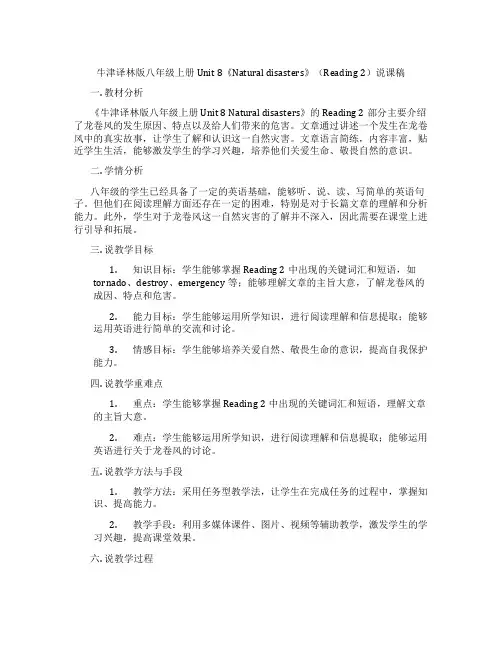
牛津译林版八年级上册Unit 8《Natural disasters》(Reading 2)说课稿一. 教材分析《牛津译林版八年级上册Unit 8 Natural disasters》的Reading 2部分主要介绍了龙卷风的发生原因、特点以及给人们带来的危害。
文章通过讲述一个发生在龙卷风中的真实故事,让学生了解和认识这一自然灾害。
文章语言简练,内容丰富,贴近学生生活,能够激发学生的学习兴趣,培养他们关爱生命、敬畏自然的意识。
二. 学情分析八年级的学生已经具备了一定的英语基础,能够听、说、读、写简单的英语句子。
但他们在阅读理解方面还存在一定的困难,特别是对于长篇文章的理解和分析能力。
此外,学生对于龙卷风这一自然灾害的了解并不深入,因此需要在课堂上进行引导和拓展。
三. 说教学目标1.知识目标:学生能够掌握Reading 2中出现的关键词汇和短语,如tornado、destroy、emergency等;能够理解文章的主旨大意,了解龙卷风的成因、特点和危害。
2.能力目标:学生能够运用所学知识,进行阅读理解和信息提取;能够运用英语进行简单的交流和讨论。
3.情感目标:学生能够培养关爱自然、敬畏生命的意识,提高自我保护能力。
四. 说教学重难点1.重点:学生能够掌握Reading 2中出现的关键词汇和短语,理解文章的主旨大意。
2.难点:学生能够运用所学知识,进行阅读理解和信息提取;能够运用英语进行关于龙卷风的讨论。
五. 说教学方法与手段1.教学方法:采用任务型教学法,让学生在完成任务的过程中,掌握知识、提高能力。
2.教学手段:利用多媒体课件、图片、视频等辅助教学,激发学生的学习兴趣,提高课堂效果。
六. 说教学过程1.导入:通过展示龙卷风的图片和视频,引导学生关注这一自然灾害,激发学习兴趣。
2.预习:让学生预习Reading 2,自主学习生词和短语,了解文章大意。
3.课堂讲解:教师引导学生学习Reading 2,讲解生词和短语,分析文章结构,讲解龙卷风的成因、特点和危害。
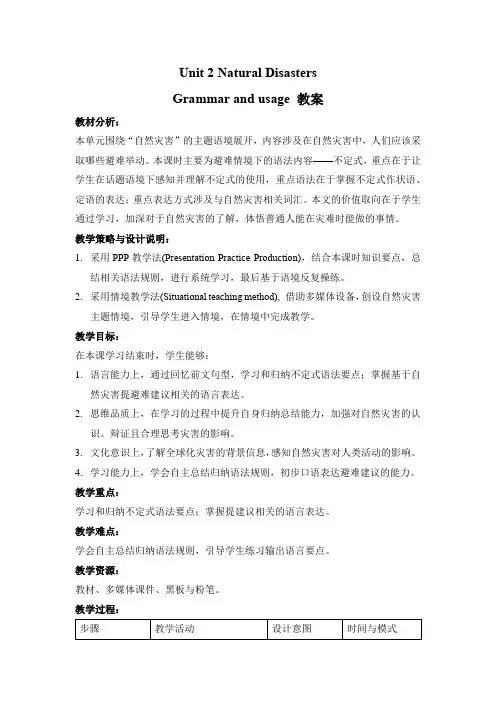
Unit 2 Natural DisastersGrammar and usage 教案教材分析:本单元围绕“自然灾害”的主题语境展开,内容涉及在自然灾害中,人们应该采取哪些避难举动。
本课时主要为避难情境下的语法内容——不定式,重点在于让学生在话题语境下感知并理解不定式的使用,重点语法在于掌握不定式作状语、定语的表达;重点表达方式涉及与自然灾害相关词汇。
本文的价值取向在于学生通过学习,加深对于自然灾害的了解,体悟普通人能在灾难时能做的事情。
教学策略与设计说明:1.采用PPP教学法(Presentation Practice Production),结合本课时知识要点,总结相关语法规则,进行系统学习,最后基于语境反复操练。
2.采用情境教学法(Situational teaching method), 借助多媒体设备,创设自然灾害主题情境,引导学生进入情境,在情境中完成教学。
教学目标:在本课学习结束时,学生能够:1.语言能力上,通过回忆前文句型,学习和归纳不定式语法要点;掌握基于自然灾害提避难建议相关的语言表达。
2.思维品质上,在学习的过程中提升自身归纳总结能力,加强对自然灾害的认识。
辩证且合理思考灾害的影响。
3.文化意识上,了解全球化灾害的背景信息,感知自然灾害对人类活动的影响。
4.学习能力上,学会自主总结归纳语法规则,初步口语表达避难建议的能力。
教学重点:学习和归纳不定式语法要点;掌握提建议相关的语言表达。
教学难点:学会自主总结归纳语法规则,引导学生练习输出语言要点。
教学资源:教材、多媒体课件、黑板与粉笔。
教学过程:ApplyingHave students finish B1 and B2 on Page 21. The teacher can explain the functions and lead students to conclude that toinfinitives can function as almost all the parts of a sentence except predicate. B1: T teaches the steps to answer the kind of problem. [Step 1: find out the topic or key word from the first half of sentences. Step 2: find out the key words from the second half of sentences to match the first half sentences. Step 3: check logical relationship]B2: T guides Ss to find out the logical relationships in the passage, and Ss fill in备注:Ss: Students T: TeacherIW: Individual work GW: Group work CW: Class work教学反思1.通过本节内容学习,学生是否掌握不定式,把握材料大意;2.通过本节内容学习,学生能否掌握归纳总结使用该语法方法。
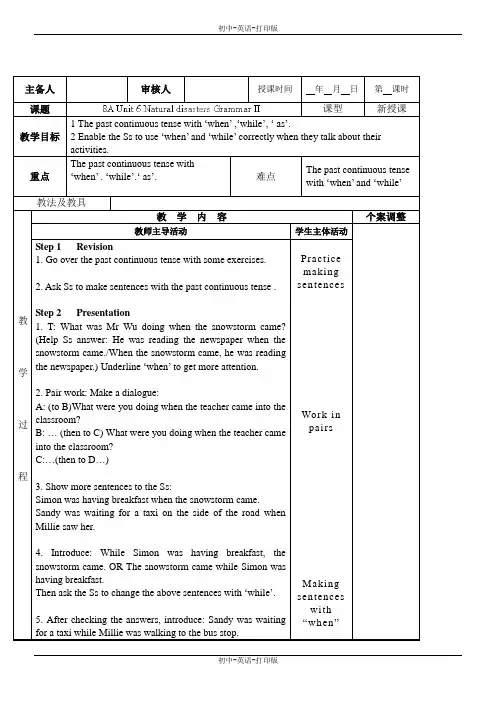
主备人审核人授课时间年月日第课时课题课型新授课教学目标1 The past continuous tense with ‘when’ ,‘while’, ‘ as’.2 Enable the Ss to use ‘when’ and ‘while’ correctly when they talk about their activities.重点The past continuous tense with‘when’ . ‘while’.‘ as’.难点The past continuous tensewith ‘when’ and ‘while’教法及教具教学过程教学内容个案调整教师主导活动学生主体活动Step 1 Revision1. Go over the past continuous tense with some exercises.2. Ask Ss to make sentences with the past continuous tense .Step 2 Presentation1. T: What was Mr Wu doing when the snowstorm came?(Help Ss answer: He was reading the newspaper when thesnowstorm came./When the snowstorm came, he was readingthe newspaper.) Underline ‘when’ to get more attention.2. Pair work: Make a dialogue:A: (to B)What were you doing when the teacher came into theclassroom?B: … (then to C) What were you doing when the teacher cameinto the classroom?C:…(then to D…)3. Show more sentences to the Ss:Simon was having breakfast when the snowstorm came.Sandy was waiting for a taxi on the side of the road whenMillie saw her.4. Introduce: While Simon was having breakfast, thesnowstorm came. OR The snowstorm came while Simon washaving breakfast.Then ask the Ss to change the above sentences with ‘while’.5. After checking the answers, introduce: Sandy was waitingfor a taxi while Millie was walking to the bus stop.PracticemakingsentencesWork inpairsMakingsentenceswith“when”。
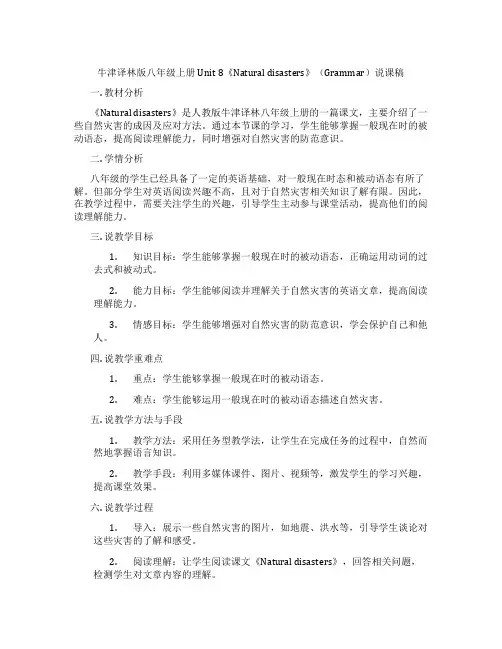
牛津译林版八年级上册Unit 8《Natural disasters》(Grammar)说课稿一. 教材分析《Natural disasters》是人教版牛津译林八年级上册的一篇课文,主要介绍了一些自然灾害的成因及应对方法。
通过本节课的学习,学生能够掌握一般现在时的被动语态,提高阅读理解能力,同时增强对自然灾害的防范意识。
二. 学情分析八年级的学生已经具备了一定的英语基础,对一般现在时态和被动语态有所了解。
但部分学生对英语阅读兴趣不高,且对于自然灾害相关知识了解有限。
因此,在教学过程中,需要关注学生的兴趣,引导学生主动参与课堂活动,提高他们的阅读理解能力。
三. 说教学目标1.知识目标:学生能够掌握一般现在时的被动语态,正确运用动词的过去式和被动式。
2.能力目标:学生能够阅读并理解关于自然灾害的英语文章,提高阅读理解能力。
3.情感目标:学生能够增强对自然灾害的防范意识,学会保护自己和他人。
四. 说教学重难点1.重点:学生能够掌握一般现在时的被动语态。
2.难点:学生能够运用一般现在时的被动语态描述自然灾害。
五. 说教学方法与手段1.教学方法:采用任务型教学法,让学生在完成任务的过程中,自然而然地掌握语言知识。
2.教学手段:利用多媒体课件、图片、视频等,激发学生的学习兴趣,提高课堂效果。
六. 说教学过程1.导入:展示一些自然灾害的图片,如地震、洪水等,引导学生谈论对这些灾害的了解和感受。
2.阅读理解:让学生阅读课文《Natural disasters》,回答相关问题,检测学生对文章内容的理解。
3.语法讲解:讲解一般现在时的被动语态,让学生通过例句和实践,掌握这一语法知识。
4.小组讨论:学生分成小组,讨论如何用英语描述一种自然灾害,以及如何防范。
5.展示与评价:每个小组选择一名代表,展示他们的讨论成果,其他同学和老师进行评价。
6.总结与反思:教师引导学生总结课堂所学,让学生反思自己在课堂上的表现,以及如何提高。

Period Ⅲ: Grammar (第三课时)第一部分教案设计教学内容Grammar(第97~98页),主要学习过去进行时的相关用法。
教材分析本课时是语法课,介绍过去现在时的用法,学习过去进行时态的结构,肯定式、否定式和一般疑问句形式、特殊疑问句,三个特殊连词:when, while, as,通过多种练习已达到对过去现在时的灵活运用。
教学目标基础知识掌握词汇:break词组:on the side of the road break down句型:I was (not) sleeping at 10 p.m. last night.I was sleeping when the earthquake started.People were running in all directions while pieces of glass and bricks were falling down.As I was trying to find my way out, I suddenly heard some noise above me.When/While/As Millie was watching TV, Andy came into the room. Millie waswatching TV when Andy came into the room.基本技能会运用过去进行时描述与本单元话题有关的内容。
综合素质:能熟练使用过去进行时的肯定句、否定句、疑问句,学会正确使用when, while, as。
教学重难点及突破重点:掌握基本的四会单词、词组及句型。
难点:能熟练使用过去进行时的肯定句、否定句、疑问句,学会正确使用when, while, as。
教学突破通过教师的讲解,让学生总结规律,找到方法,再让学生举例,通过做练习来检查巩固。
教学准备教师准备:多媒体课件及关于本课时语法的实例及习题学生准备:关于Simon前一天所做事情的图片。
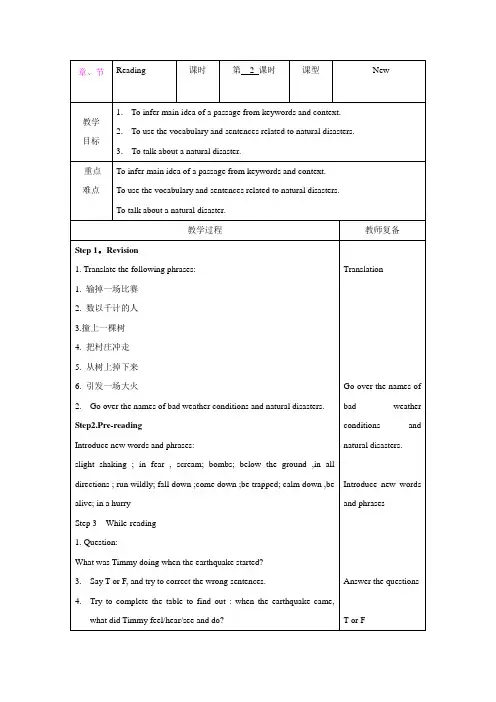
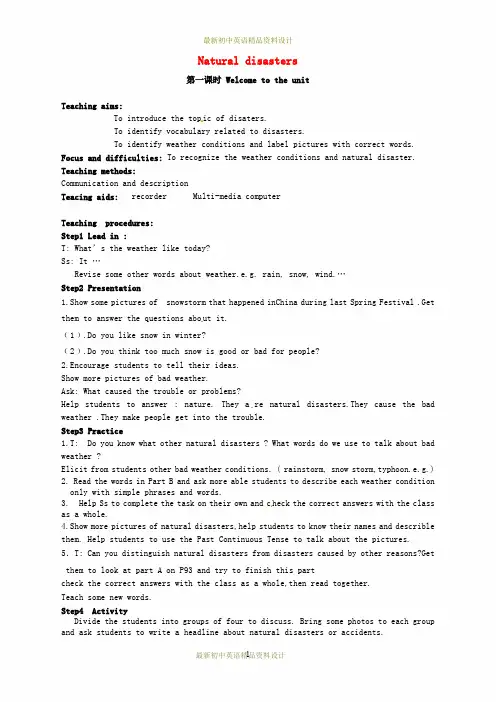
Natural disasters第一课时 Welcome to the unitTeaching aims:To introduce the top ic of disaters.To identify vocabulary related to disasters.To identify weather conditions and label pictures with correct words. Focus and difficulties: To recognize the weather conditions and natural disaster. Teaching methods:Communication and descriptionTeacing aids: recorder Multi-media computerTeaching procedures:Step1 Lead in :T: What’s the weather like today?Ss: It …Revise some other words about weather.e.g. rain, snow, wind.…Step2 Presentation1.Show some pictures of snowstorm that happened inChina during last Spring Festival .Get them to answer the questions abo ut it.﹙1﹚.Do you like snow in winter?﹙2﹚.Do you think too much snow is good or bad for people?2.Encourage students to tell their ideas.Show more pictures of bad weather.Ask: What caused the trouble or problems?Help students to answer : nature. They a re natural disasters.They cause the bad weather .They make people get into the trouble.Step3 Practice1.T: Do you know what other natural disasters ? What words do we use to talk about bad weather ?Elicit from students other bad weather conditions. ( rainstorm, snow storm,typhoon.e.g.)2. Read the words in Part B and ask more able students to describe each weather conditiononly with simple phrases and words.3. Help Ss to complete the task on their own and c heck the correct answers with the class as a whole.4.Show more pictures of natural disasters,help students to know their names and describle them. Help students to use the Past Continuous Tense to talk about the pictures. 5.T: Can you distinguish natural disasters from disasters caused by other reasons?Get them to look at part A on P93 and try to finish this partcheck the correct answers with the class as a whole,then read together.Teach some new words.Step4 ActivityDivide the students into groups of four to discuss. Bring some photos to each group and ask students to write a headline about natural disasters or accidents.Step5 Presentation1.T: Look at the pictures ,people suffered from these natural disasters . What can we do to help them.Students will discuss it warmly. Then teacher leads students to the comic strip.2.T:Hobo has some trouble. What happened to him? Let’s have a look. Students look at the pictures. Teacher asks some open questions about each picture.1).What’s the weather like?( It’s raining)2). What happened to Hobo?( He got wet.)3).What was Hobo doing when it started to rain? ( He was sleeping)4).Did he hear the rain? ( Half an hour later.)5).What do you think happened o Hobo’s house?(The floor was all wet.)6). Why doesn’t he want to go home alone?(Because he wants Eddie to mopall the water up)7).Will Eddie help him?(No. I don’t think Eddie likes his idea.)2. Play the tape and students read after it.Explain some language points.Step 5.gamesAsk students to role-play the conversation.Step 6.Homework:Revises the contents we have learned.Preview Reading8A Unit6 Natural disastersReading(1)Teaching aims:1.To infer the meaning from the key words,pictures and the context.2.To elicit any information about the earthquakes in Taiwan orin other parts of the world.3.To develop the Ss’ability and skills reading comprehension andlet the Ss learn how to describe natural disasters and how o protectthemselves in the natural disasters.Difficult points: The key words and phrases the comprehension of the story. Teaching methods: reading and talkingTeacing aids: recorder Multi-media computerTeaching procedures:Step1 Lead in :T: we have learnt some natural disastrs last time .What disasters have we leart?Encourage students to say something about the natural disasters.Show some picturs of an earthquake that happened in Wengchuan,sichuan on May12,2008 . Step2 Presentation1.Let the students guess the new words by showing the pictures and talk about the earthquake that happened in Sichuan.2.T: What do people often feel/do when the earthquake happened? etc.Teach some new words and phrases.shake v. 摇动,震动(shaking n. )hear a big noise like thunder 听到一声像打雷一样的声音in fear (be frightened) 害怕,恐惧Scream v. 尖叫run in all directions 奔向四面八方run wildly 疯狂地奔跑fall down 掉下来come down 倒塌,塌陷3.After learning these new words ,help students finish PatrB1. Check it together.4.T: There was an earthquake in Taiwan in 1999. Many people lost their lives in the earthquake , but a boy called Timmy surrived. Let’s listen to the story to see what happened to himStep3 Listening and skiming1.Play the tape for Studenets and check general understanding by asking some ‘wh’questions and doing exercises PartC.2.Students skim the passage and do exercises on PartD.Step4 Reading and answering1. Listen and read after the tape one paragraph by one paragraph.Check if they understand by asking more questions about the passage.2.Invite the students to read the whole passage in front of the class.Encourage them to mime and gesture in order to illustrate the different aspects of the experience.Step5. Practice1.Ask stuednts to read the sentences in the boxes in PartC and fill in the blanks. Check the answers with the whole class.2.Divide the students into groups of four.Retell the story ,then encourage some of them to retell in front of the class.Homework1.Recite the new words .2.Try to read the story as fluently as you can8A Unit6 Natural disastersReading(2)Teaching aims:1.To scan the passage.2.To explain some difficult and important language points and to use them.3.To make an interview about the earthquake.Difficult points: some language structuresTeaching methods: reading and talkingTeacing aids: recorder Multi-media computerTeaching procedures:Step1 revision1.Revise the names of natural disasters.2.Show the students the photos of the story of Taiwan earthquake and help them to retellit.Step2 ScanningScan each paragraph and encourage the students to tell their difficulties.Teacher helps students to solve them. Teacher explains language points to students. shaking (n.)震动,摇动Fear (n.)恐惧,害怕一阵恐惧a moment of fearin fear 在恐惧中direction方向,方位人们四处逃散。
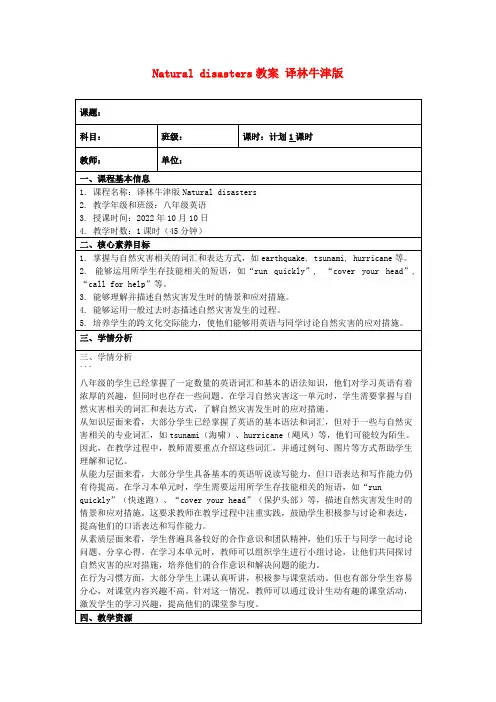
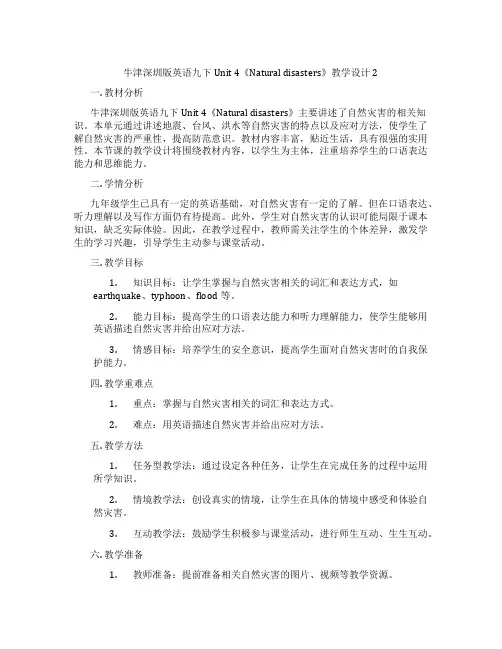
牛津深圳版英语九下Unit 4《Natural disasters》教学设计2一. 教材分析牛津深圳版英语九下Unit 4《Natural disasters》主要讲述了自然灾害的相关知识。
本单元通过讲述地震、台风、洪水等自然灾害的特点以及应对方法,使学生了解自然灾害的严重性,提高防范意识。
教材内容丰富,贴近生活,具有很强的实用性。
本节课的教学设计将围绕教材内容,以学生为主体,注重培养学生的口语表达能力和思维能力。
二. 学情分析九年级学生已具有一定的英语基础,对自然灾害有一定的了解。
但在口语表达、听力理解以及写作方面仍有待提高。
此外,学生对自然灾害的认识可能局限于课本知识,缺乏实际体验。
因此,在教学过程中,教师需关注学生的个体差异,激发学生的学习兴趣,引导学生主动参与课堂活动。
三. 教学目标1.知识目标:让学生掌握与自然灾害相关的词汇和表达方式,如earthquake、typhoon、flood等。
2.能力目标:提高学生的口语表达能力和听力理解能力,使学生能够用英语描述自然灾害并给出应对方法。
3.情感目标:培养学生的安全意识,提高学生面对自然灾害时的自我保护能力。
四. 教学重难点1.重点:掌握与自然灾害相关的词汇和表达方式。
2.难点:用英语描述自然灾害并给出应对方法。
五. 教学方法1.任务型教学法:通过设定各种任务,让学生在完成任务的过程中运用所学知识。
2.情境教学法:创设真实的情境,让学生在具体的情境中感受和体验自然灾害。
3.互动教学法:鼓励学生积极参与课堂活动,进行师生互动、生生互动。
六. 教学准备1.教师准备:提前准备相关自然灾害的图片、视频等教学资源。
2.学生准备:预习教材,了解自然灾害的基本知识。
七. 教学过程1.导入(5分钟)利用图片或视频展示自然灾害的场景,引导学生谈论自己对自然灾害的了解和感受。
教师简要介绍本节课的主题和目标。
2.呈现(10分钟)教师展示教材中的图片,引导学生用英语描述图片中的自然灾害。
Unit8 Natural disasters 教案。
牛津译林版八年级上册XXX Aims:1.XXX natural disasters.2.XXX.3.XXX natural disasters.Step 1: XXXXXX。
earthquake。
storm。
lightning。
and fire。
Read the new words aloud and have the students repeat them.Step 2: Vocabulary PracticeHave students complete Part A on page 93 to practice using XXX.Step 3: XXXXXX aid.Step 4: Listening and Speaking PracticeXXX.Step 5: XXXXXX.Step 6: Vocabulary ReviewXXX in class。
such as "mop up" which means to clean up or dry off a surface.1.XXX disasters in the world every day.2.I heard of a car accident here.3.- What was the weather like yesterday?It was sunny but windy.4.XXX Friday.5.XXX his bike just now.6.I XXX.1.The weather will get worse next week.XXX for next week is uncertain.2.Thousands of people died in the XXX.3.Their house XXX.Homework:1.Memorize the XXX.plete the workbook exercises.Reading IXXX Aims:1.XXX.e XXX.3.Practice XXX."Step 1: XXXIntroduce new words with pictures and read them aloud: slightXXXloudfearXXXnin all ns brick come down XXXnot at all nervous XXX XXX XXX calmcalm down sincestillXXXdark shoutat last daylight safeXXXafterfind one's way outStep 2: Match the words on the left with their meanings on the right.plete part B1 on page 95.2.Check your answers.Step 3: XXXLook at some pictures and discuss "What is an XXX?"Step 4: Listening1.Listen to the text and complete part B3.2.Check your answers.Timmy was playing in his house when suddenly there was a loud noise and everything XXX't know what was XXX't move because he was XXX for help but no one could hear him。
Unit 8 Natural disastersComic strip and welcome to the unitTeaching Aims:1. To learn the new words and phrases2. To meet the past continuous tense3. Talk about some natural disaster.Step 1 Presentation1. Show some pictures to learn some words.2. Then read aloud the new words.disaster mop up earthquake thousands of accident coach crash flood wash away village lightning storm thunder catch fire Step 2 Do some exercises.Do Part A on page 93.Check the answers.Step 3 PresentationShow some pictures to present comic strip.Step 4 Listen and answer1. Listen to the tape and answer the follow questions.1) What’s the weather like2) What happened to Hobo3) What was Hobo doing when it started to rain4) Did Hobo hear the rain5) Why doesn’t he want to go home alone6) What do you think of Hobo2. Read the dialogue in pairs.3. Act it out.Step 6 Listening1. Listen to part B and answer the following question.1) What happened to Vivien’s school2) When did it happen2. Read after the recorder.3. Pratice in pairs.4. Act it out.5. Make their own dialogue.Step 7 Explanation1. wake up 醒过wake sb. up 叫醒某人e.g. I wake up at six every morning!我每天早上六点钟醒来。
牛津译林版八年级上册Unit 8《Natural disasters》(Task)教学设计一. 教材分析牛津译林版八年级上册Unit 8《Natural disasters》主要介绍了自然灾害,包括地震、洪水、台风等,通过学习本单元,学生可以掌握有关自然灾害的词汇和表达方式,了解自然灾害发生的原因及应对措施。
Task部分要求学生阅读一篇关于自然灾害的文章,然后进行相关练习,培养学生的阅读能力和解决问题的能力。
二. 学情分析八年级的学生已经具备了一定的英语基础,能够进行简单的阅读和交流。
但部分学生在阅读长篇文章时,可能会遇到生词和语法难题,影响阅读理解。
此外,学生对于自然灾害的了解程度不一,需要教师在教学中进行引导和补充。
三. 教学目标1.知识目标:学生能够掌握有关自然灾害的词汇和表达方式,了解自然灾害发生的原因及应对措施。
2.能力目标:学生能够阅读并理解关于自然灾害的文章,提高阅读能力;通过任务型教学,培养学生的解决问题能力。
3.情感目标:培养学生关爱生命,关注自然的意识,提高学生应对自然灾害的能力。
四. 教学重难点1.重点:学生能够掌握有关自然灾害的词汇和表达方式,阅读并理解关于自然灾害的文章。
2.难点:学生能够运用所学知识,解决实际问题,提高应对自然灾害的能力。
五. 教学方法1.任务型教学法:通过任务型教学,让学生在实践中掌握知识,提高能力。
2.情境教学法:创设情境,让学生在真实的环境中学习,提高学生的学习兴趣。
3.合作学习法:引导学生进行小组合作,培养学生的团队精神和沟通能力。
六. 教学准备1.教师准备:提前准备关于自然灾害的文章,整理相关词汇和表达方式,设计任务型练习。
2.学生准备:预习课文,了解自然灾害的基本知识,准备参与课堂活动。
七. 教学过程1.导入(5分钟)教师通过提问方式引导学生谈论自然灾害,激发学生的学习兴趣。
例如:“你们知道哪些自然灾害?它们发生的原因是什么?”2.呈现(10分钟)教师呈现关于自然灾害的文章,让学生快速阅读,了解文章大意。
unit2 natural disasters reading教案
教学目标:
1. 学生能够阅读有关自然灾害的文章。
2. 学生能够掌握新单词及短语的含义。
3. 学生能够理解自然灾害对人们的影响。
教学步骤:
1. 引入
老师可以通过图片、视频等形式引入自然灾害。
可以展示几张图片,向学生解释图片中的情景,并询问学生对自然灾害的认识。
引发学生对本课的兴趣。
2. 学习新单词及短语
老师可以通过PPT、直接写在黑板上等方法呈现新单词及短语,并让学生快速记忆。
3. 阅读文章
让学生阅读文章,重点指出文章中的关键词和理解文章的重要内容。
4. 分组讨论
将学生分成小组,让他们一起讨论文章中的问题,鼓励他们口语交流。
5. 互动小活动
让学生根据文章中的内容,模拟一发生自然灾害的情况,并让他们进行表演,鼓励学生的表现欲望。
6. 课后作业
让学生完成一篇关于自然灾害的论文或作文,以便检验学生对于课堂知识的掌握程度。
教学方法:
1. 演绎法
通过演绎的方式,让学生更直接的理解自然灾害对于人们的影响。
2. 合作学习法
通过合作学习法,培养学生做好团队协作的能力,同时也增强了学生的信心。
3. 边学边做法
通过边学边做法,使学生能够更快速的理解知识点,例如学习新单词后,可以让学生立即在文本中找寻其应用,并加以理解。
总之,通过以上的教学方法以及教学过程,学生们将能够在老师的指导下,更好的理解自然灾害的形成原因及其对人类的影响,同时也会更好地掌握相关词汇及理解文章。
Period I: Comic strip & Welcome to the unit(第一课时)第一部分教案设计教学内容Comic strip & Welcome to the unit(第92~93页),通过卡通向学生呈现Eddie 和Hobo谈论大雨给他们造成的损失,同时使学生学习一些重要句型,例如… was/ were doing when …; Didn’t you hear …; …if…等。
教材分析“Comic strip”通过Eddie和Hobo的卡通向学生呈现大雨给他们造成的损失,同时学习一些重要句型--…was /were doing when …;Didn’t you hear …;…if…等,通过熟读对话,根据A部分的知识做铺垫,谈论Welcome to the unit 部分的各种自然灾难,同时也让学生有了防范“自然灾难”的意识,从而能够去爱护自然,减少自然灾害。
教学目标:基础知识掌握词汇:up, earthquake ,coach , flood, village, storm , disaster, mop, accident, crash, lightning, thunder, natural词组:lose final, thousands of , wash away, catch fire,mop up,句型:I was sleeping when it started to rain../Didn’t you hear the rain?/ Who is going to mop up the water if I go home without you ?基本技能1.了解几种常见自然灾难的英文名称。
2.能区别自然灾难和事故。
3.学会简单谈论常见的自然灾难及其导致的后果。
综合素质了解自然灾难的破坏性,激发爱护自然之情。
教学重难点及突破重点:掌握基本的四会单词、词组及句型。
难点:能区别自然灾难和事故。
教学突破:课前让学生做一些准备,上查找一些自然灾难的资料,为对话做一些铺垫。
教学准备教师准备:多媒体课件学生准备:查阅关于自然灾难和事故的信息。
教学设计Step I Lead-in 导入1. Free talk : What’s the weather like today ? Is there any bad weather in our city?2.复习有关天气的词汇,如:windy, cloudy, foggy, rainy, snowy等。
Step II Present "Comic strip" (新授Comic strip)l. Guess what’s wrong with Hobo.2.回答下列问题:⑴What’s the weather like ? ( It’s raining .)⑵What did Hobo see when he woke up ? (He see water everywhere.)⑶What was Hobo doing when it started to rain ? ( He was sleeping.)⑷Why doesn’t he want to go home alone? (He needs Eddie to mop up the water.)3. 播放课文录音,学生跟读。
4. 板书:was sleeping , 解释过去进行时的概念。
5.练习对话,要求加上自己的动作、表情,模仿正确的语音语调,鼓励上台为全班表演。
Step III Present "Welcome to the unit" (新授Welcome to the unit)1. What can you see in the picture?/ What happened to these things/people?2.归纳:They’re different from accidents. They are all caused by natural forces. 板书:accident natural 区别总结: Accidents are usually caused by people.3. Guessing games:描述几种灾难猜是何种灾难。
4. Can you tell the difference between natural disasters and accidents now? Here are some newspaper headlines. Please discuss in pairs to find out which ones are natural disasters?5. Practice reading the new words and phrases.板书:lose final,crash into, wash away, lightning, storm, start fire6. Get students to complete Part A,7.集体核对答案,提醒学生体会新闻标题的书写特点。
Step IV Practice(操练)l. Sandy and Millie are chatting online about natural disasters and accidents. Please listen to their conversation and answer some questions:2. 再次播放录音,要求学生跟读,注意模仿正确的语音和语调。
3. 先操练课本对话,使用课前准备的材料替换部分对话内容。
4 3-4组不同层次的学生上台表演,及时给与评价和表扬。
随堂小练习Ⅰ用所给词的适当形式填空。
1 Han is the______ ( win )of the basketball match.2 I hope there ______ ( be ) another charity show.3 There are_______ ( hundred) of people by the sea.4 1 ______ ( sleep ) when it started to rain.5 Look! Eddie ______ ( mop )up the floor.6 There are many students ______ ( play ) football in the playground7 The earthquake in Tangshan______ ( kill ) millions of people.8 I______ ( not go ) back home until I finish my homework.9 You will know the result of the car accident two hours_____ late.10 You will get ______ (lose) if you go out by yourself.【keys】Ⅰ1. winner 2. will be 3. hundreds 4. was sleeping 5. is mopping 6. playing 7. killed 8. won't go 9. later 10. lostStep V Homework(作业)1. 向别人介绍更多的自然灾难。
2. 熟读、背诵B部分的对话。
3. 记忆本课时所学的词汇和词组。
4.预习Reading教材习题英语书第93 页(Which are about natural disasters ?Put a tick (√)in the correct boxes.)Keys: Part A:2. √ 5 √ 6 √ 8 √板书设计教学探讨与反思:本节课是整个单元的导入教学,从学生熟悉的天气入手,充分了解学生的认知起点,全面地把握教学目标,精心设计教学过程,再加上课前的准备资料,学生在课堂上有话要说,对话部分也有话可说,同时培养了学生的探究兴趣。
教学设计科学、合理、有趣味,提高了教学质量。
教师利用好这一导入板块,为学生营造了发展的空间,激发了学生的学习兴趣和主动学习的欲望,培养了学生的语言运用能力,从而为接下来的学习做铺垫!第二部分讲解分析一、新词的导学与解读1 natural【用法】adj. 自然的,自然界的;天生的自然灾难natural disasters天然食物natural food 自然美景natural beauty【举例】Milk is the natural food for young babies. 牛奶是婴儿的天然食物。
It’s natural that a child should love it’s mother. 孩子爱母亲,这是很自然的。
【实践】根据汉语意思完成句子。
他喜欢观看自然景象。
He likes watching a __________ phenomenon.【点译】natural自然界的【实践】根据汉语意思完成句子。
跑了200公里后,自然就累了。
It’s quite _________ to be tired after running 200 kilometres.【点译】natural 自然的【拓展】nature n. 自然界,大自然nature reserve 自然保护区【举例】If we walk out, we will feel the beauty of the nature.如果我们走出去,我们就会感受到大自然的美。
【实践】根据汉语意思完成句子就顺其自然吧。
Just let _______ take its course,【点译】nature2. mop【用法】vt. 用拖把擦干净;洗擦把水擦干净mop up the water【举例】First I swept the floor.,then I mopped it up. 我先扫了地,然后拖地。
【拓展】(1) mop 是及物动词,其过去式和过去分词都是双写-p 加–ed ,mop-mopped,现在分词mopping.(2)mop 可构成短语mop…up,其后接名词可置于mop或up之后,如接代词必须置于mop与up之间,如:mop it up , mop the floor up= mop up the floor【实践】根据汉语意思完成句子。
既然我把牛奶溅出来了,我就该把它清理干净。